INTERNACIONAL
Salió a bailar con amigas, desapareció y la encontraron muerta en un descampado: el crimen de las 19 puñaladas que conmocionó a Madrid
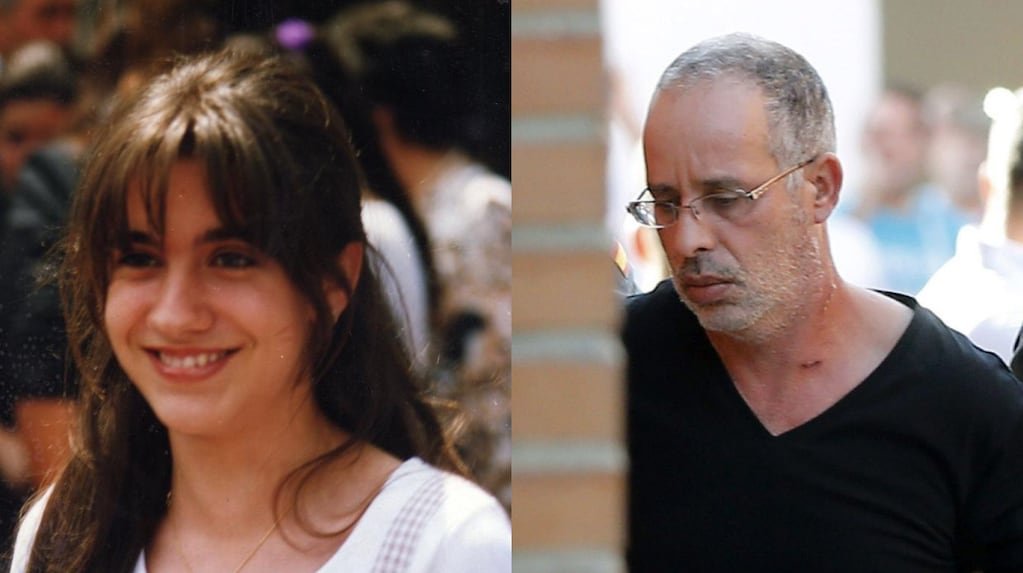
En la madrugada del 20 de abril de 1997, los vecinos de Algete, en Madrid, quedaron impactados con una trágica noticia: habían encontrado el cuerpo de una adolescente en un descampado en las afueras de la ciudad.
Se trataba de Eva Blanco, una estudiante de 16 años que había salido esa misma noche con sus amigas a una fiesta y que poco después de separarse del grupo, se la perdió de vista.
Leé también: Envenenó a la familia de su exmarido con un hongo letal y ahora podría ser condenada a prisión perpetua
La escena del hallazgo parecía sacada de una película de terror: el cadáver de Eva presentaba varias puñaladas y tenía indicios de haber sido atacada sexualmente.
La investigación del caso se convirtió en una de las más enigmáticas de España, ya que la policía trabajó en varias hipótesis y estuvo detrás de decenas de pistas. Sin embargo, el caso no se resolvió hasta 18 años después, cuando la ciencia permitió identificar a su femicida gracias a un avance en la tecnología forense.
La noche del horror
Según la reconstrucción de los investigadores, el día de su desaparición Eva salió de su casa alrededor de las 17:00 y se encontró con sus amigos en un negocio. Dos horas y media más tarde, el grupo fue hasta la Urbanización Valderrey a una fiesta que se realizó en un complejo de canchas de tenis.
Vanesa, su mejor amiga, declaró que la joven la acompañó a las 23:45 hasta su casa y que, supuestamente, de ahí tenía pensando irse a la suya. Sin embargo, no tomó el mismo camino de siempre y nunca llegó.
La familia denunció su desaparición a las autoridades de inmediato, aunque pocas horas después, un vecino encontró su cuerpo al costado de una ruta.
En un principio, la investigación apuntó a que Eva había mantenido relaciones sexuales con alguien de manera voluntaria y que, por algún motivo, mientras iba a su casa la mataron. Eva Blanco tenía 16 años cuando fue brutalmente asesinada en abril de 1997. (Foto: El Confidencial)
Los resultados de la autopsia encajaban con estos supuestos: la muerte de la joven se produjo entre las 2 y las 4 de la madrugada, y fue asesinada de 20 puñaladas (19 en la nuca y espalda y una en un dedo) con una navaja. A su vez, detectaron rastros de semen en su ropa interior.
“Llegué a pensar que había tenido un accidente, que la habían atropellado”, explicó Manuel Blanco, el padre de la adolescente, en una entrevista que dio en 2013 con La Sexta. “Al final, estuvimos buscándola por las cunetas, por si le hubiera pasado algo”, sumó.
Sobre la última tarde junto a su hija, su mamá Olga Puig, recordó: “Me dijo que la dejara salir hasta las 00, pero yo no quería. Fue la última vez que la vi y me siento muy culpable por dejarla salir hasta esa hora“.
En este escenario, la policía se encontraba frente a un gran enigma con pocas pruebas y una tecnología forense que aún estaba en su etapa inicial. Pese a ello, había una hipótesis que resonaba con fuerza: que Eva debía conocer a su asesino, ya que se trataba de una persona precavida con los desconocidos.
La autopsia determinó que la joven recibió 20 puñaladas. (Foto: Heraldo de Aragón)
Por este motivo, los investigadores reconstruyeron la vida de la adolescente en un perfil psicológico: analizaron sus amistades, sus pensamientos y su forma de relacionarse con otros gracias a los escritos de su diario íntimo, que los efectivos incautaron durante un allanamiento en su casa.
Sin embargo, a pesar de los esfuerzos, no lograron detectar ninguna pista que los llevara a un sospechoso.
El giro en la investigación que permitió dar con el acusado
Durante casi 19 años, los agentes de la Guardia Civil investigaron a más de 5000 personas con antecedentes por agresiones sexuales y realizaron más de 2000 pruebas de ADN, donde la mayoría de las personas eran vecinos de Eva y presentaron las muestras de manera voluntaria.
Pero en 2013, un grupo de investigadores decidió revisar el caso con técnicas avanzadas en la genética forense y eso permitió encontrar una pista concreta.
Ese año, se sometió a nuevas pruebas el ADN que se encontró en la escena de 1997. Los resultados señalaron un dato revelador: el perfil genético correspondía a un hombre magrebí por su cadena de cromosomas.
Esta información abrió un nuevo camino para la policía, que decidió comenzar a comparar el ADN con muestras de familias residentes en Algete con ese origen. Fue entonces cuando el análisis recayó sobre un hombre que había vivido en la zona en la década de los 90. Al tomar una muestra de uno de sus hermanos, la policía halló una coincidencia del 50% que apuntaba directamente a esta persona.
El sospechoso señalado fue Ahmed Chelh Gerj, de origen marroquí, que en ese momento vivía en Francia. Según detalla el expediente, había llegado a España cuando era joven y había trabajado en diferentes lugares en el rubro de la construcción. A fines de los 90, se mudó al país vecino, donde formó una familia, tuvo tres hijos y llevó una vida medianamente normal. El femicida de Eva, Ahmed Chelh Gerj, fue detenido en octubre de 2015. (Foto: La Razón)
Tras un operativo en conjunto entre la Guardia Civil española y la policía francesa, Ahmed fue detenido en la puerta de su casa en Pierrefontaine-les-Varans, una pequeña localidad al este de Francia, en octubre de 2015.
En su declaración, dijo que en la noche que Eva fue asesinada, él había salido a caminar solo por la zona y que, de un momento a otro, dos deconocidos lo secuestraron y lo llevaron al descampado en donde encontraron el cuerpo de la joven. Luego, “lo habrían obligado a masturbarse sobre el cadáver”.
La extradición a España se concretó semanas después y los medios locales volvieron a cubrir el caso. “Ahora, al menos, sabemos quién fue”, declaró la madre de la adolescente en ese momento. “Estábamos esperando este día desde hace 18 años. Lloré con los agentes cuando me dijeron que habían detenido al asesino de mi hija”, sumó el padre.
El acusado ingresó a la cárcel de Alcalá-Meco a la espera del juicio, pero inesperadamente, en mayo de 2016, lo encontraron muerto en su celda. Según la versión oficial, el hombre se quitó la vida.
Leé también: Su niñera la secuestró cuando era una bebé y más de 50 años después se reencontró con sus padres biológicos
Para la familia Blanco, la muerte del sospechoso significó un alivio a medias, ya que por un lado, la identificación y la detención confirmaban que la investigación no había sido en vano; pero por el otro, el acusado dejaba el caso sin una condena judicial.
Hoy, el crimen de Eva sigue siendo recordado en España como uno de los enigmas más grandes de la historia criminal del país.
España, Homicidio, adn, 16 años, puñaladas
INTERNACIONAL
¿Paquetes al espacio?: Viajar en cohete y dormir en una estación espacial privada, ida y vuelta por 100 millones de dólares

«Voluntad política»
Modelo económico
INTERNACIONAL
Comey and James challenge Trump appointee’s legitimacy in federal court hearing

NEWYou can now listen to Fox News articles!
Former FBI Director James Comey and New York Attorney General Letitia James are aiming to convince a federal judge on Thursday that Lindsey Halligan, who brought criminal charges against both of them, is an unlawful U.S. attorney.
Lawyers for Comey and James plan to make their arguments during a hearing in Virginia to Judge Cameron Currie, a Clinton appointee tasked with deciding Halligan’s fate.
President Donald Trump installed Halligan in September as the top prosecutor in the Eastern District of Virginia days after ousting Erik Siebert, who opposed charging Comey and James, two of the president’s top political nemeses. Amid the change, Trump posted a remarkable message to Attorney General Pam Bondi on Truth Social, indicating that he wanted revenge for his own prior prosecutions and that Bondi needed to act fast.
Halligan, a former insurance lawyer with no prosecutorial experience, brought the indictments almost immediately. Her name was the lone signature on each of them, and no Virginia prosecutors joined the case.
TRUMP’S US ATTORNEYS IN BLUE STATES FACE LEGAL CHALLENGES THAT COULD UPEND KEY PROSECUTIONS
President Donald Trump named lawyer Lindsey Halligan as interim U.S. Attorney Eastern District of Virginia in September. (Marco Bello/AFP via Getty Images)
In court briefs, Comey’s and James’ lawyers have said Halligan’s appointment was defective because Bondi improperly designated her as an interim U.S. attorney after Siebert had already served in that position, which had a 120-day term limit that had expired.
Because Halligan was the lone prosecutor to sign the grand jury indictments, legal experts have said that could be their fatal flaw if the courts deem her invalid.
Bondi has since said she retroactively ratified the indictments and designated Halligan a «special attorney» for the «avoidance of doubt,» according to court filings.
«In all events, the government has endorsed the prosecutions, and the Attorney General has personally ratified the indictments to obviate any question as to their validity,» DOJ lawyers wrote.
COMEY SEEKS TO TOSS CRIMINAL CASE CALLING TRUMP PROSECUTOR ‘UNLAWFUL’ APPOINTEE

Attorney General Pam Bondi speaks alongside President Donald Trump on recent Supreme Court rulings in the briefing room at the White House on June 27, 2025, in Washington, D.C. (Joe Raedle/Getty Images)
Halligan’s appointment came as part of a series of maneuvers the Trump administration has made to bypass the Senate confirmation process and keep in place his preferred appointees in temporary capacities using loopholes in federal vacancy laws. Federal judges in New Jersey, California and Nevada have disqualified appointees in those states, and the New Jersey case is now pending before an appellate court. The issue could be bound for the Supreme Court.
Comey’s lawyers argued in court papers that Currie, the judge presiding over the issue, «should reject the government’s machinations.»
Comey is facing a charge that he made a false statement to Congress and James is facing a bank fraud allegation.
DOJ DEFENDS TRUMP TRUTH SOCIAL POST AS COMEY SEEKS TO HAVE CASE DISMISSED

Former FBI Director James Comey testifies before the Senate Intelligence Committee about his interactions with President Donald Trump and the Russia investigation on June 8, 2017, in Washington, D.C. (Cheriss May/NurPhoto via Getty Images)
CLICK HERE TO GET THE FOX NEWS APP
Both have pleaded not guilty and have argued their indictments should be tossed out on the grounds that Halligan was improperly appointed and that they were selectively and vindictively prosecuted.
If Comey’s and James’ charges were to be thrown out, it is unclear what would happen. The DOJ could appeal or attempt to bring them again, depending on how the courts rule.
Fox News’ Bill Mears and David Spunt contributed to this report.
justice department,pam bondi,judiciary,virginia,donald trump
INTERNACIONAL
Argentina reveals secret WWII files on Hitler’s henchmen who fled before, after the war

NEWYou can now listen to Fox News articles!
Multiple documents featuring some of the worst Nazi war criminals were released and declassified earlier this year by Argentine President Javier Milei. The more than 1,850 documents comprise thousands of pages detailing the South American country’s efforts to track and verify the whereabouts of thousands of Nazis who fled Europe after World War II.
The catalyst for the effort came from the Senate Judiciary Committee and Chairman Chuck Grassley, R-Iowa, who was credited by the Simon Wiesenthal Center for his efforts in getting Milei to release the documents.
Most of the materials relate to investigations carried out between the late 1950s and the 1980s and were digitized and made available on the nation’s General Archive website, along with secret, declassified presidential decrees from 1957 to 2005.
The original batch of documents released online is divided into seven large files roughly centered around the main Nazi criminals covered in them. There are multiple documents related to Adolf Eichmann, the engineer of the «Final Solution,» the plan for the extermination of European Jewry. He lived under the name Ricardo Klement around Buenos Aires until being captured by Mossad agents on Argentine soil and taken in a secret operation to stand trial in Jerusalem in 1960.
101-YEAR-OLD KRISTALLNACHT SURVIVOR WARNS CURRENT ERA ‘EQUIVALENT TO 1938’ ON ANNIVERSARY OF NAZI RIOT
Adolf Eichmann, in a bulletproof cabin, puts on earphones to hear the reading of the act of accusation against him, Dec. 17, 1961. He was in charge of the extermination of Jews in Poland and then organized the deportation and extermination of Jews in 13 European countries. (Keystone-France/Gamma-Keystone via Getty Images)
Eichmann’s case features prominently in the files and there is contradicting evidence that the leftist, populist government of Juan Perón not only knew Eichmann was in the country but also made efforts to protect him.
Multiple documents also exist detailing the lives of Josef Mengele, the «angel of death» doctor from Auschwitz-Birkenau camps who lived in Argentina and escaped to Paraguay and Brazil, where he died in 1979.
Documents detailing the hunt for Martin Bormann, Hitler’s lieutenant and right-hand man, as well as Croatian murderer, Ante Pavelic, deputy führer and defector Rudolf Hoess and the so-called «butcher of Lyon,» Klaus Barbie, received special attention in the files.
NAZI OFFICER’S DAUGHTER CHARGED AFTER STOLEN WWII PAINTING SPOTTED IN REAL ESTATE LISTING
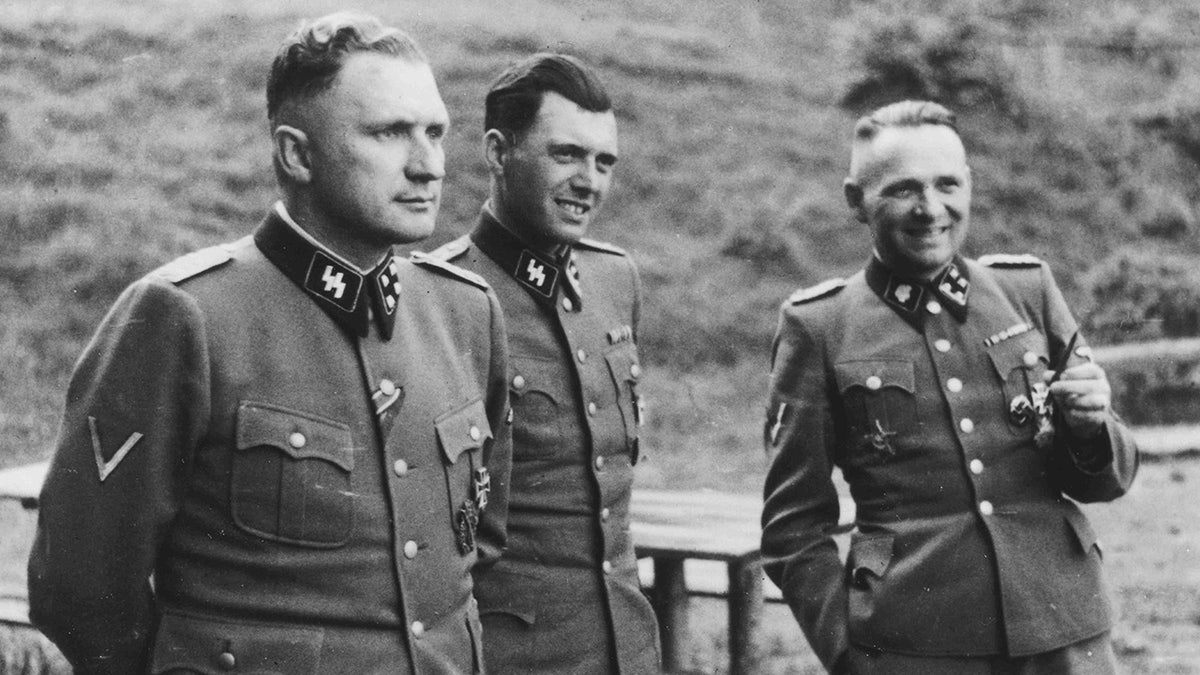
Three SS officers socialize on the grounds of the SS retreat outside of Auschwitz, 1944. From left to right they are: Richard Baer (commandant of Auschwitz), Dr. Josef Mengele and Rudolf Hoess (the former Auschwitz commandant). Mengele escaped to Argentina, later escaping to Paraguay and Brazil. (Universal History Archive/Universal Images Group via Getty Images)
According to Harley Lippman, a member of the United States Commission for the Preservation of America’s Heritage Abroad and a board member of the European Jewish Association, the relevance of the release of the Argentinian documents cannot be understated.
«There are numerous questions that these documents can bring light to why a sophisticated society, far from the plagues of European antisemitism such as Argentina’s, agreed to hide Nazi criminals and their secrets for so long. What happened to the U-boats loaded with Nazi gold brought to the country and given to the authorities?» he asked.
«On the one hand, it is shameful that Argentina kept these documents a secret for so long, but on the other hand, we also need to acknowledge the enormous efforts being made by this government to make these documents public. While the historical significance is important, this is more important for Argentinians to be able to confront their demons as a society than for Jews,» Lippman said.
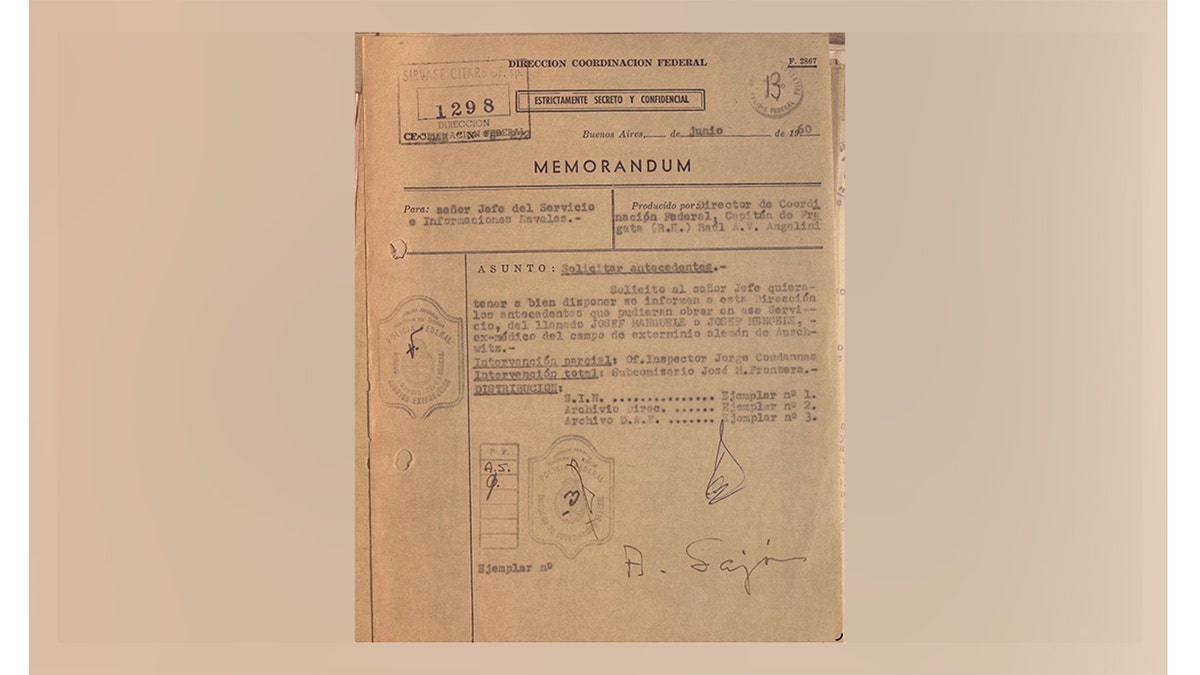
This 1950 Argentine federal police memo, marked strictly secret and confidential, seeks intelligence on Josef Mengele, the notorious Nazi doctor from Auschwitz, suggesting that Argentine authorities were aware of his possible presence or activity in the region at that time. (General Archives of the Government of Argentina)
Adding to the large reveal, in May, while the Supreme Court of Argentina was undergoing renovations and transferring document collections to museums, a forgotten trove of 83 boxes of Nazi documents was discovered almost untouched in the basement of the institution. Upon inspection, the crates revealed documents intercepted by Argentine customs in 1941, sent from the German Third Reich Embassy in Tokyo, Japan, to Argentina’s capital, Buenos Aires, aboard the Japanese steamer Nan-a-Maru.
The documents had been sent as personal effects of embassy personnel but were intercepted under orders of the country’s minister for foreign affairs in order not to undermine Argentina’s neutral position in the war. The shipment became the subject of a probe by a commission investigating «anti-Argentine activities,» which led to the seizure and possession of the crates by the country’s supreme court, where they remained for nearly 84 years.
The finding of the boxes revealed multiple materials intended to propagate and consolidate the Third Reich’s and Hitler’s ideologies in Argentina and South America, possibly in an effort to bring neutral countries under the auspices of Germany.
MILEI SCORES HISTORIC WIN IN ARGENTINA MIDTERMS, TIGHTENS GRIP ON CONGRESS
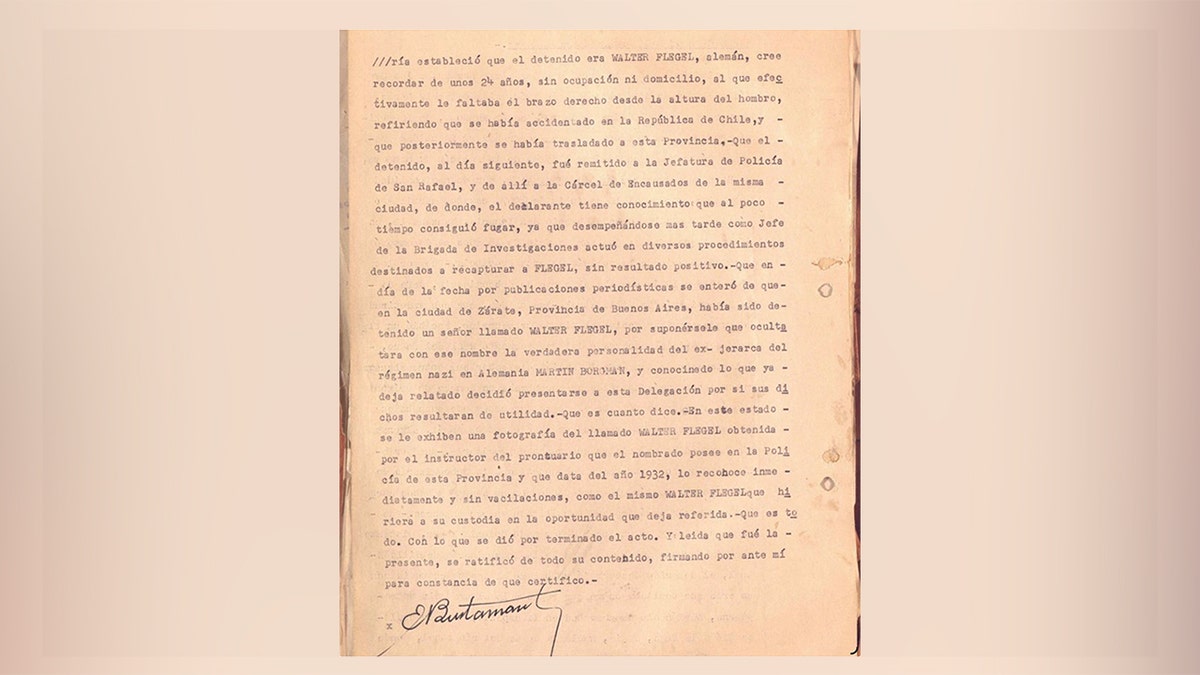
The document recounts an Argentine police report describing a German fugitive, Walter Flegel, believed by some to be Martin Bormann, Hitler’s former deputy, living under a false identity in Argentina. It was later proven that the lead was incorrect and that Flegal was not Borman. Earlier this year, Argentina President Javier Milei declassified and released over 1,850 documents detailing Argentina’s efforts to track and verify the whereabouts of thousands of Nazi war criminals. (General Archives of the Government of Argentina)
After opening the boxes along with prominent members of the country’s Jewish community, the court issued a statement saying that «given the historical relevance of the find and the potential crucial information it could contain to clarify events related to the Holocaust,» an exhaustive survey of all the material was ordered.
The contents of the crates have not yet been made public, but Milei’s office has said that once all the documents have been digitized, they will also be declassified and made available.
Argentina’s chief of the Cabinet of Ministers, Guillermo Francos, has previously said Milei gave the order «because there is no reason to continue withholding that information, and it is no longer in the interest of the Republic of Argentina to keep such secrets.»
«Jews after World War II lived a golden age of about 80 years where antisemitism had subsided, at least apparently, and they could be productive and contributing members of society. This has now ended — partially because of the genocide committed against Israelis by Hamas on Oct. 7, 2023, with world opinion projecting on Israelis and Jews the false role of perpetrators of genocide in the war in Gaza, but also by bringing back the same old antisemitic views that had been alive in Germany and before then,» Lippman says.
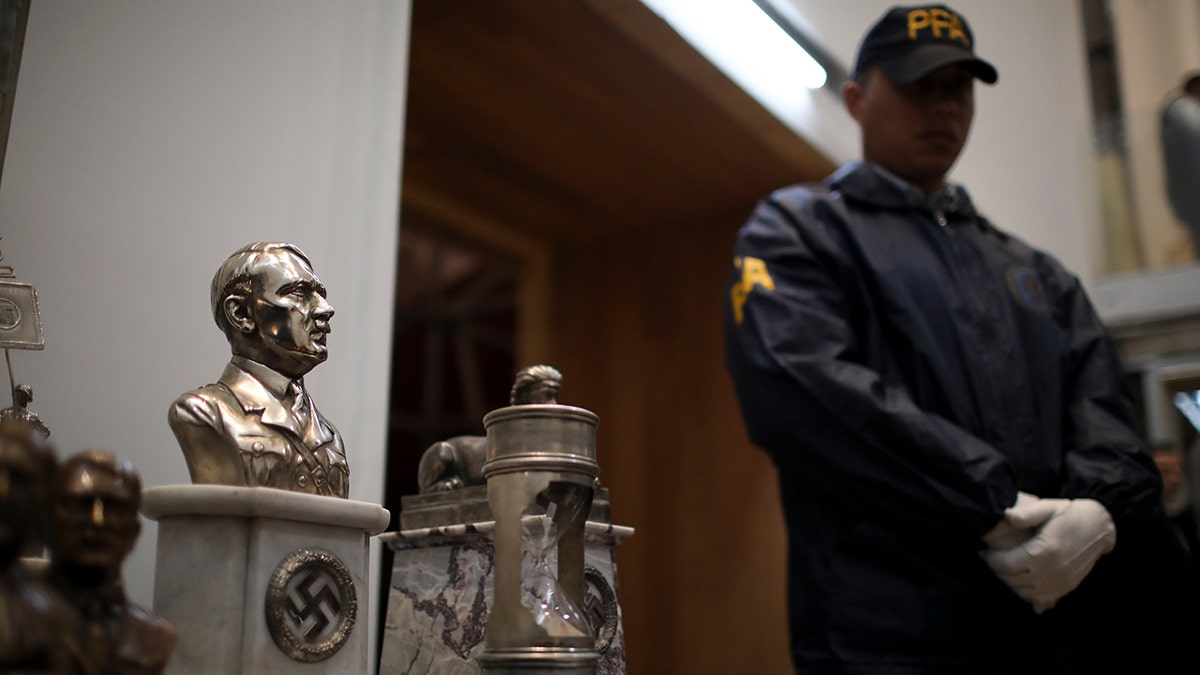
A police officer stands in front of a cache of Nazi artifacts discovered in 2017, during a press conference in Buenos Aires, Argentina, Wednesday, Oct. 2, 2019. Argentine authorities found the cache in a secret room behind a bookcase and had uncovered the collection in the course of a wider investigation into artwork of suspicious origin found at a gallery in Buenos Aires. (Natacha Pisarenko/AP Photo)
«The fact that many people under 30 do not know or understand [the meaning of] the Holocaust is part of the reason why antisemitism is on the rise again. «The Holocaust was the largest systematic industrial killing of humans in history. This happened only 80 years ago. Young people seem not to be able to grasp the scale of this, but these documents can bring back the memory of what the Holocaust really was,» he said, comparing the propaganda war currently faced by Israel and Jews under a progressive and projectionist guise.
CLICK HERE TO DOWNLOAD THE FOX NEWS APP
Beyond the lives of senior Nazis who escaped to South America on the so-called «ratlines»—possibly under the auspices of certain local governments—Lippman said the documents could also provide important information regarding the role played by Swiss and Argentine banks.
«The Holocaust was the greatest theft in history. Many Swiss banks [which were the depositaries of Jewish money] would not release funds to sometimes a sole survivor from a family who perished in the Holocaust without a death certificate for their loved ones. But Auschwitz did not issue death certificates — they only issued ashes.»
anti semitism,south america,world war two,israel,holocaust

 CHIMENTOS2 días ago
CHIMENTOS2 días agoWada Nara se despidió de sus hijas con un desgarrador mensaje al entregárselas a Mauro Icardi: «Que la pasen hermoso»

 POLITICA2 días ago
POLITICA2 días agoAxel Kicillof prometió no subir impuestos, pero montó un mecanismo de recaudación con Ingresos Brutos

 POLITICA2 días ago
POLITICA2 días agoEn Formosa cobran un impuesto a los camiones para poder circular: piden que el gobierno nacional intervenga





























